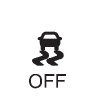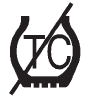Chevrolet Cruze Owners Manual: Traction Control System (TCS)
The vehicle has a Traction Control System (TCS) that limits wheel spin.
On a front-wheel-drive vehicle, the system operates if it senses that one or both of the front wheels are spinning or beginning to lose traction. When this happens, the system brakes the spinning wheel(s), and/or reduces engine power to limit wheel spin.
The system may be heard or felt while it is working, but this is normal.
TCS is on whenever the vehicle is started. To limit wheel spin, especially in slippery road conditions, the system should always be left on. But, TCS can be turned off if needed.

TCS/StabiliTrak Light
 flashes to indicate that the traction
control system is active.
flashes to indicate that the traction
control system is active.
If there is a problem detected with TCS, SERVICE TRACTION CONTROL and SERVICE STABILITRAK may be displayed on the Driver Information Center (DIC).
When this message is displayed and d comes on and stays on, the vehicle is safe to drive but the system is not operational.
Driving should be adjusted accordingly.
If  comes on and stays on, reset the
system:
comes on and stays on, reset the
system:
1. Stop the vehicle.
2. Turn the engine off and wait 15 seconds.
3. Start the engine.
If  still comes on and stays on at
a speed above 20 km/h (13 mph), see your dealer for service.
still comes on and stays on at
a speed above 20 km/h (13 mph), see your dealer for service.
A chime may also sound when the light comes on steady.
Notice: Do not repeatedly brake or accelerate heavily when TCS is off. The vehicle's driveline could be damaged.

TCS/StabiliTrak Button
 is located on the console.
is located on the console.

TCS Off Light
TCS can be turned off by pressing and releasing
 . When TCS is turned off,
. When TCS is turned off,
 comes on and the system will not limit
wheel spin.
comes on and the system will not limit
wheel spin.
Driving should be adjusted accordingly. Press and release
 again to turn the system back on.
again to turn the system back on.
It may be necessary to turn the system off if the vehicle gets stuck in sand, mud, or snow and rocking the vehicle is required. If cruise control is being used when TCS activates, cruise control will automatically disengage. Press the cruise control button to reengage when road conditions allow.Adding non-GM accessories can affect the vehicle's performance.
 StabiliTrak® System
StabiliTrak® System
The vehicle has a vehicle stability enhancement system called StabiliTrak. It
is an advanced computer controlled system that assists with directional control
of the vehicle in difficult driving co ...
Other materials:
Installation Procedure
Cut the front compartment front rail in corresponding locations to fit
the remaining original panel. The sectioning joint should be
trimmed to allow a gap of one-and-one-half-times the metal thickness at the
sectioning joint.
Create a 50 mm (2 in) backing plate from the unused porti ...
Installation Procedure
Prepare all mating surfaces as necessary
Align the body lock pillar outer panel reinforcement.
Drill 8 mm (5/16 in) for plug welding along the edges of the body lock
pillar outer panel reinforcement as noted from the original
panel.
Clean and prepare the attaching surfac ...
Removal Procedure
Warning: Refer to Approved Equipment for Collision Repair Warning in the
Preface section.
Warning: Refer to Collision Sectioning Warning in the Preface section.
Warning: Refer to Glass and Sheet Metal Handling Warning in the Preface section.
Disable the SIR System. Refer to SIR Disabling ...

